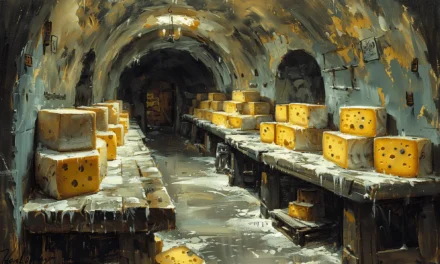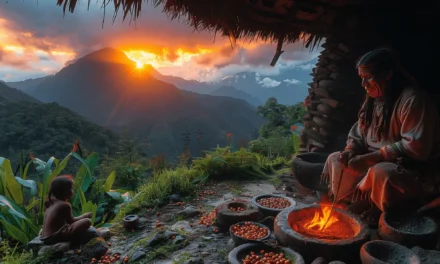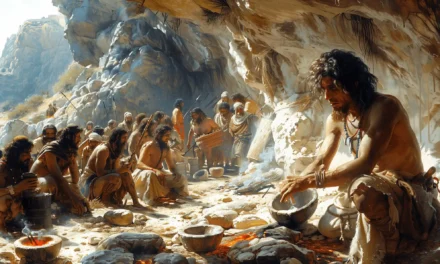Sancocho is like Colombia’s treasured soup child – born of a beautiful fusion of the culinary customs of the many cultures that call Colombia their home. This beloved soup has had a place at the Colombian dinner table forever, and its warm, flavorful embrace is a reminder of a past filled with many joys but also much hard work. So if you ever have the pleasure of tasting Sancocho, don’t just dive in – salute it before your first spoonful and savor the historical richness that each unique flavor brings.
A Stew of Convenience: Understanding Sancocho
The delicious dish of Sancocho has an interesting story about its origin. It’s kinda like a storybook fairytale but with a culinary twist. Although theories vary, one popular belief is that its name is derived from an adaptation of the traditional “Puchero” from Iberia, created with the ingredients that were readily available in the Americas. Others speculate that it’s a spin on the French term “sans cochon” or “without pork,” which was a common restriction during the Medieval period1.
Ángel Rosenblat (1987) suggested that the classic Caribbean stew “sancocho” got its start from the term “sub-coctum” – aka, “half-cooked.” It’s a term that’s been around since the colonial period to describe a hearty soup or stew made with meat, vegetables, and just about whatever else is available. Sancocho wasn’t complicated in the beginning, so a group of folks could easily throw a few ingredients together and whip up a delicious dinner in no time1.
Let’s Dish It Out: Sancocho As Symbol Of Reunion
It’s as if the recipe for Sancocho was a universal language shared by all Colombians – a language that has been passed down from generation to generation since the 17th century! Although we don’t know for sure who first created the dish, there is a popular theory that it was brought to the region by African enslaved who were doing hard labor in the area. So, you can consider Sancocho as a tribute to their history and resilience2.
When the first enslaved men arrived in working camps and settlements, they were faced with a daunting task – how to feed themselves, with no women or people from the tribe who knew how to cook. However, they rose to the challenge, and drew inspiration from the Spanish recipe for “Olla Podrida”, creating something similar with the ingredients available2.
Instead of saying sancocho is not a specialized technique, let’s say it’s the perfect dish for a multitasker! That’s because enslaved communities didn’t have the luxury of taking their time in the kitchen – they had to create an amazing dish in a flash. And so, it makes sense that this dish is something of a symbol of reunion and community since it requires everyone to work together and unite to get the job done in a hurry2.
Stews That Sing: Exploring the Versatile Sancocho
Thanks to tales shared by inquisitive wanderers, compassionate missionaries, and seasoned officers, we can get an accurate picture of the delicious Sancocho that was commonly enjoyed throughout the colonial era. Especially prevalent in rural areas close to the rivers, this beloved dish was a favorite among residents of the Caribbean region, who sang its praises in each and every city like a foodie’s choir3.
Sancocho is like the lifeblood of people’s daily lives, especially in rural areas – it’s a savory stew and a symbol of comfort, a warm hug from the inside out. It’s a recipe that dates all the way back to the XVI century, similar to the Caribbean’s ever-popular ‘ajiaco’. Folks love to tuck in to a hearty bowl and there are endless varieties of ingredients that can be used depending on the region you’re in4.
Speaking the Sancocho Language: A Secret Language Known by All Colombians
Colombia is a veritable smorgasbord of sancochos! You can find a different version of this iconic dish in every corner of the country, with recipes tailored to the individual region’s array of ingredients, including local animal proteins and proximity to the sea, rivers, mountains, and valleys. For more than a hundred years, sancocho has been the soup star of family get-togethers, relationships, and even rival disputes. It’s a magical food that brings people together and has them seeing eye-to-eye like nothing else. It’s a delicious way to come to a compromise if you will1 5.
Some customs might have developed a way with the times, but families and small entrepreneurs still make sure to follow the time-honored recipes for classic sancocho. It’s like the old-fashioned Sunday roast that grandma used to make; it might not be quite the same as the traditional recipe, but it still takes you back to the good ol’ days. It’s no longer a village fair, but rather, the major cities in Colombia have become a hubbub of activity and exchange of ideas4.

- De Castro, A., & Gutiérrez de Piñeres, V. (2012). Semiótica del sancocho: aglutinador social de la costa Caribe colombiana. In R. Delgado, Selección de ensayos sobre alimentación y cocinas de Colombia (pp. 441-446). Bogotá: Ministerio de Cultura.[↩][↩][↩]
- Garcés Arellano, M. A., & Barney Cabrera, E. (2012). Con cagüinga y con callana. Notas y apostillas al margen de un libro de cocina. Retrieved from Biblioteca básica de Cocinas Tradicionales de Colombia: http://patrimonio.mincultura.gov.co/SiteAssets/Paginas/Publicaciones-biblioteca-cocinas/biblioteca%203.pdf[↩][↩][↩]
- Illera, C. H. (2012). Nuestras cocinas desde el Nuevo Reino de Granada (siglo XVI) hasta la República (siglo XIX), a la luz de los escritos de algunos cronistas y viajeros. Retrieved from Biblioteca básica de Cocinas Tradicionales de Colombia: https://www.mincultura.gov.co/Sitios/patrimonio/bibliotecas-de-cocinas/tomos/tomo04.pdf[↩]
- Patiño Ossa, G. (2012). Fogón de negros, cocina y cultura en una región latinoamericana. Retrieved from Biblioteca básica de Cocinas Tradicionales de Colombia: https://www.mincultura.gov.co/Sitios/patrimonio/bibliotecas-de-cocinas/tomos/tomo08.pdf[↩][↩]
- Moreno Blanco, L. (2012). Palabras junto al fogón. Selección de golosos textos culinarios y antología de viandas olvidadas. Retrieved from Biblioteca básica de Cocinas Tradicionales de Colombia: https://www.mincultura.gov.co/Sitios/patrimonio/bibliotecas-de-cocinas/tomos/tomo14.pdf[↩]




